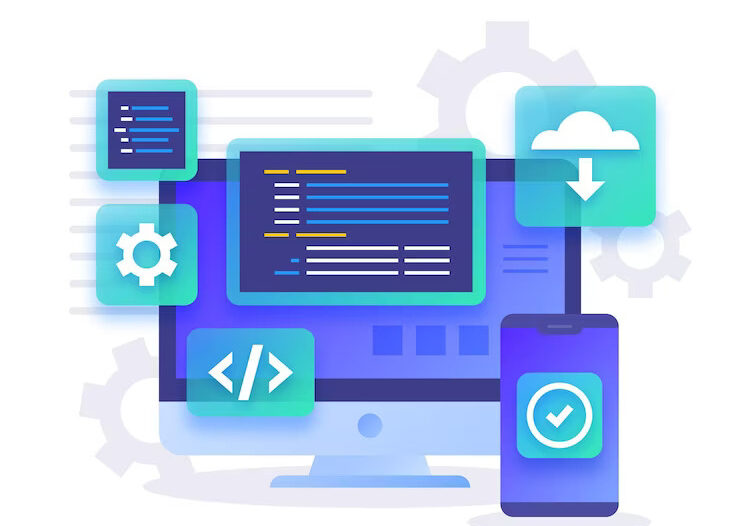The Evolution of Application Development
- 1 Evolution of Application Development
- 1.1 The Dawn of Application Development
- 1.2 The Rise of the Internet and Web Applications
- 1.3 Mobile Application Development
- 1.4 Microservices and Decentralized Architectures
- 1.5 Containers and Consistent Deployment
- 1.6 Serverless Computing and the Cloud
- 1.7 Modern Challenges in Application Development
- 2 The Future of Application Development
- 2.1 Low-Code/No-Code Development:
- 2.2 Artificial Intelligence and Machine Learning Integration:
- 2.3 Containerization and Microservices:
- 2.4 Serverless Computing:
- 2.5 Cross-Platform Development:
- 2.6 Progressive Web Apps (PWAs):
- 2.7 Blockchain and Decentralized Applications:
- 2.8 Augmented Reality (AR) and Virtual Reality (VR):
- 2.9 Quantum Computing:
- 2.10 Cybersecurity and Privacy:
- 2.11 Sustainability and Green Computing:
- 2.12 Accessibility and Inclusivity:
- 2.13 Edge Computing:
- 3 Conclusion
Software application development has always been at the forefront of the digital age, serving as the backbone of technological advancement. This article aims to trace the historical evolution of application development, highlighting its key milestones and the transformative advances that have shaped it.
Evolution of Application Development

The Dawn of Application Development
In the early days of software application development, applications were primarily command-line-based with limited user interfaces. These were the days of monolithic architectures, where applications were built as single, indivisible entities. While monolithic applications had their advantages, they also had inherent limitations, especially in terms of scalability and flexibility.
The Rise of the Internet and Web Applications
The rise of the World Wide Web marked a revolutionary shift in application development. This period saw a transition from traditional desktop applications to web-based applications, which offered unprecedented benefits in terms of accessibility and cross-platform compatibility.
Mobile Application Development
The software development landscape underwent another significant change with the arrival of smartphones. Mobile applications became the new norm, catering to the needs of users on the go. Discussions about the types of mobile applications – native, web, or hybrid, each with its own set of benefits and challenges – intensified.
Microservices and Decentralized Architectures
Breaking free from the constraints of monolithic architectures, the software industry began to embrace microservices. In this approach, applications were developed as a collection of loosely coupled, independent services. Microservices offer numerous benefits, including scalability, resilience, and deployment flexibility, making them a preferred choice for modern application development.
Containers and Consistent Deployment
Containers were a game changer in the application delivery landscape. They provided a consistent environment for applications, ensuring seamless deployment across platforms. Docker, in particular, gained immense popularity as the leading containerization tool, streamlining the deployment process and reducing compatibility issues.
Serverless Computing and the Cloud
Serverless computing introduced a paradigm where developers could focus solely on writing code, leaving infrastructure management to cloud providers. This approach offered benefits such as cost efficiency and scalability. However, it also presented challenges such as cold starts and potential vendor lock-in.
Modern Challenges in Application Development
As application architectures evolved, so did the challenges. Increasing security threats in the modern application landscape underscored the need for integrated security practices. In addition, the complexity of managing modern application architectures presented its own set of challenges that required innovative solutions.
The Future of Application Development
Low-Code/No-Code Development:
Low-code and no-code platforms have gained significant traction. They empower individuals with limited coding experience to build applications using visual interfaces and pre-built components. This trend is expected to continue, making application development more accessible to a wider audience.
Artificial Intelligence and Machine Learning Integration:
AI and machine learning are increasingly being integrated into applications. Developers are leveraging AI for predictive analytics, personalization, and automation. AI-driven development tools are also becoming more prevalent.
Containerization and Microservices:
Containerization technologies like Docker and orchestration platforms like Kubernetes have become essential for building scalable and portable applications. The shift towards microservices architecture allows for better flexibility, scalability, and maintenance.
Serverless Computing:
Serverless computing, which abstracts server management from developers, is gaining popularity. It simplifies application deployment and scaling, reducing infrastructure management overhead.
Cross-Platform Development:
With the proliferation of mobile and desktop platforms, cross-platform development tools like React Native, Flutter, and Electron have gained momentum. These enable developers to create applications that work across multiple operating systems.
Progressive Web Apps (PWAs):
PWAs are web applications that offer a native app-like experience, including offline access and push notifications. They are becoming more important in the mobile and web development space.
Blockchain and Decentralized Applications:
Blockchain technology is finding applications beyond cryptocurrencies, with the development of decentralized applications (dApps). These apps run on blockchain networks, offering transparency, security, and trust.
Augmented Reality (AR) and Virtual Reality (VR):
AR and VR are transforming the way applications are developed. This technology is being used in fields like gaming, education, healthcare, and more.
Quantum Computing:
Although still in its infancy, quantum computing has the potential to revolutionize application development by solving complex problems that are currently infeasible for classical computers.
Cybersecurity and Privacy:
As data breaches and cyber threats continue to rise, security and privacy will remain top priorities in application development. Developers need to integrate robust security features from the outset.
Sustainability and Green Computing:
Sustainable practices and green computing are gaining attention. Developers are looking for ways to reduce energy consumption and make applications more environmentally friendly.
Accessibility and Inclusivity:
There is a growing focus on making applications more accessible to users with disabilities. Developers are incorporating features to ensure inclusivity and compliance with accessibility standards.
Edge Computing:
Edge computing brings processing closer to the data source, reducing latency and improving real-time processing. It is gaining traction in IoT and other applications where low latency is crucial.
The future of application development will continue to be shaped by these and other emerging technologies and trends. Developers will need to stay updated and adapt to these changes to create innovative and competitive applications in an ever-evolving landscape.
Conclusion
Reflecting on the journey of application development, from its humble beginnings to its current state, provides a fascinating insight into the world of technology. As we stand on the cusp of future advancements, the realm of application development promises endless possibilities, innovation, and transformation.

















